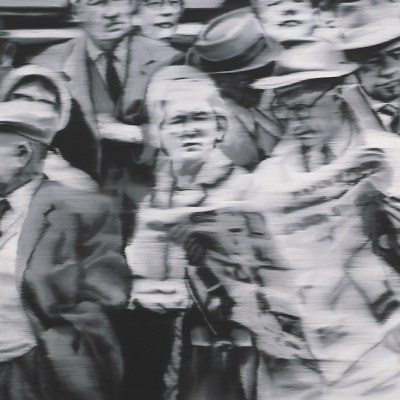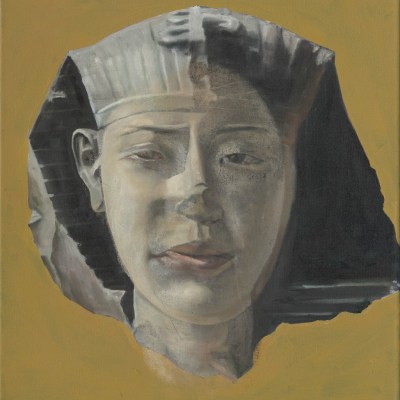From the September 2023 issue of Apollo. Preview and subscribe here.
An Isa Genzken retrospective is a tricky proposition. Since announcing herself in the mid 1970s via her Ellipsoids and Hyperboloids – maths-driven variants on minimalism that resemble hypermodern spears and oars – the German artist has always addressed the present, whereas survey shows by definition pull one into the past. Also, a lot of her work takes the form of tall, rectangular columns, and if these aren’t cannily distributed they can feel repetitious and variation-like. (See, as a caution, the strikingly inert single-file layouts of Genzken’s overview at the Kunsthalle Wien in 2014.) ‘75/75’, which celebrates her 75th birthday later this year by bringing together a corresponding number of sculptures from 1977 to the present day at the Neue Nationalgalerie in Berlin, vibrantly skirts both of those issues.
The exhibition operates both as a spread of individual objects, to be perused at leisure, and as an unofficial Gesamtkunstwerk. It occupies a substantial part of the ground-floor of the gallery, and Genzken’s freestanding artworks – plus a few dangling from the ceiling – are spaced, without snapping to any kind of grid, in a way that balances breathing room and proximity, signal and buzzy background noise. Given the big-windowed, open-plan space and Genzken’s fondness for collaging together offcuts of consumer culture, the show resembles both a kind of screwball anti-capitalist showroom, and an extended wake for the modernist high-mindedness on which Mies van der Rohe’s building was itself founded. Perhaps because of the shortage of wall space, Genzken’s vital body of photography is omitted; but the absence of walls also allows for a mass of interesting and shifting sightlines that point up connections between her bodies of work. Though roughly chronological, and encouraging the visitor to slalom up and down lines of sculptures, ‘75/75’ is arranged so that you can always see her future(s), temporalities twisting together, formal continuities and developments abounding.
Installation view of ‘Isa Genzken: 75/75’ at the Neue Nationalgalerie, Berlin in 2023. Photo: Nationalgalerie – Staatliche Museeum zu Berlin/Jens Zie; courtesy Galerie Buchholz; © VG Bild-Kunst, Bonn, 2023

Passing through the opening salvo of sleek minimalism and Genzken’s subsequent concrete radios with metal aerials from the 1980s – oblique self-portraits of the artist as antenna, ‘receiver’ of what’s in the air – you arrive at her first works inspired by architectural detailing. After looking at the concrete-and-steel Fenster (‘windows’) series, begun in 1990, you might look through them, positioned as they are as apertures on to the rest of the exhibition, and see where Genzken’s interest in modern buildings, particularly towers, will lead her. First, to glossy semi-abstractions such as X (1992), a skeletal, goldenly glowing epoxy-resin sculpture built on X shapes and inspired by load-bearing innovations built into the John Hancock Center in Chicago. Then, in the mid to late ’90s, to high-rise-like vertical columns corrupted with neon swatches and silvery spray paint, fake marbling, the odd giant musical note. And, pivotally, to the Fuck the Bauhaus series of 2000: tall plywood plinths, painted in bright colours and with mirrored tiling attached, serving as bases for all manner of sparkling, lashed-together real-world flimflam: deceptively artless arrangements of pizza boxes, fake flowers, plastic netting, tiny plastic figures and toy cars (the entire career of the feted American artist Rachel Harrison is here in embryonic form).
From this point, leaving modernist idealism in the dust and suggesting that if everything has turned to crap and nonsense it might as well be used in a clarifying manner, Genzken at once revels in and archly critiques our gaudy age of disposability and declining expectations. Artificiality also allows for wild shifts of scale, an aspect of her work forecast on the gallery’s steps by Pink Rose (2016/23), a cast-aluminium flower standing some eight metres tall. In Empire/Vampire, Who Kills Death 1 (2003), a plastic medieval figure tumbles around in a giant wine glass splashed with white paint, a blanket of mirror-foil draped over it, while at its base smaller plastic figures, some of them robots, are caught in a comical face-off – toys from some forgotten franchise remobilised into a short-circuiting narrative.
Synthetic stand-ins for the human figure pop up a lot in Genzken’s works from the 2000s, in diversifying ways: often they suggest widespread infantilisation, as well as a weakening of social bonds. Untitled (2006), one of several works involving an abandoned baby, finds a doll in a sun chair under a tattered green-and-red umbrella; the ‘baby’ is brought to affective life by being besmirched with greyish spray paint and given oversized corrective glasses. Formally, here are more leftovers sharply realigned, but the work feels deeply if abstractly lonesome. Then of course there are the trademark mannequins, here ranging from a blank-faced, half-masked boy in a silver-splashed coat – a snapshot of the artist herself bulldog-clipped to his forehead – to a twisted half-naked woman lying on the floor, wearing flares and with her breasts roughly outlined in marker pen, while a mirror behind her turns the work into a distorted memory of the Rokeby Venus. That the past is forever getting traduced in Genzken’s work, maybe in ways not entirely free from distorting nostalgia, is perhaps nowhere more clearly signalled than in her sequence of Nefertiti busts (the original is in the Neues Museum in Berlin). This time, the Egyptian queen gets painted white and decked out with dust mask and goggles in one case; paired with a stack of plastic coat hangers in another.
Genzken, whose enduring struggle with bipolar disorder is no secret, has effectively retired; the last work here dates from five years ago. Appropriately, she signs off with a pile of what amounts to articulate trash, on the floor where it belongs. Untitled (2018) is a modest spread of now-yellowing German newspapers and magazines from that year, their headlines amounting to a bleak but startlingly economical cultural diagnosis: ‘Being Confident’, ‘An Expensive Dream’, ‘This Is Why We Need Sexism’, ‘Zero Hour’, plus a fancy-department-store carrier bag, all of this lashed together with spray paint and, for old times’ sake, silver tape. Genzken began working, four and a half decades earlier, at the tail-end of hopeful high modernism; between then and the recent past, she suggests, we only fell, and fixed nothing. Nonetheless, the restlessly inventive and probing course of ‘75/75’ makes the downward spiral feel like a ride worth taking.
‘Isa Genzken: 75/75’ is at the Neue Nationalgalerie, Berlin, until 27 November.
From the September 2023 issue of Apollo. Preview and subscribe here.



